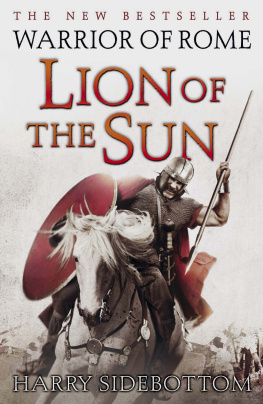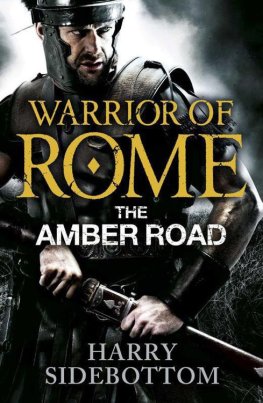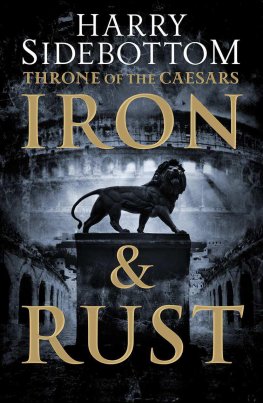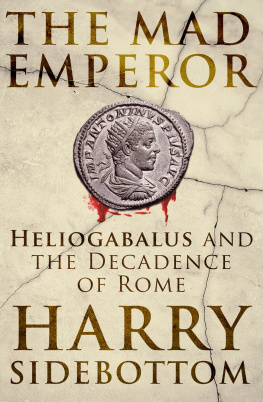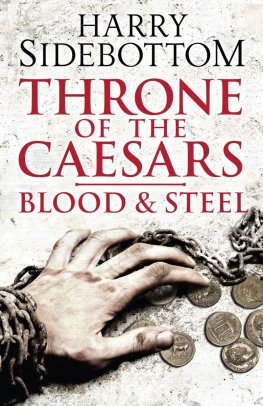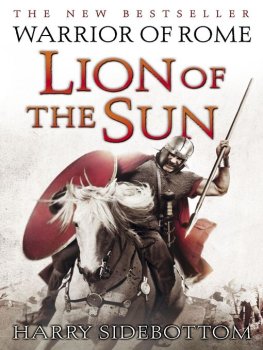Harry Sidebottom - Warrior of Rome III: Lion of the Sun
Here you can read online Harry Sidebottom - Warrior of Rome III: Lion of the Sun full text of the book (entire story) in english for free. Download pdf and epub, get meaning, cover and reviews about this ebook. year: 2010, publisher: Penguin Books Ltd, genre: Detective and thriller. Description of the work, (preface) as well as reviews are available. Best literature library LitArk.com created for fans of good reading and offers a wide selection of genres:
Romance novel
Science fiction
Adventure
Detective
Science
History
Home and family
Prose
Art
Politics
Computer
Non-fiction
Religion
Business
Children
Humor
Choose a favorite category and find really read worthwhile books. Enjoy immersion in the world of imagination, feel the emotions of the characters or learn something new for yourself, make an fascinating discovery.
- Book:Warrior of Rome III: Lion of the Sun
- Author:
- Publisher:Penguin Books Ltd
- Genre:
- Year:2010
- Rating:5 / 5
- Favourites:Add to favourites
- Your mark:
- 100
- 1
- 2
- 3
- 4
- 5
Warrior of Rome III: Lion of the Sun: summary, description and annotation
We offer to read an annotation, description, summary or preface (depends on what the author of the book "Warrior of Rome III: Lion of the Sun" wrote himself). If you haven't found the necessary information about the book — write in the comments, we will try to find it.
Warrior of Rome III: Lion of the Sun — read online for free the complete book (whole text) full work
Below is the text of the book, divided by pages. System saving the place of the last page read, allows you to conveniently read the book "Warrior of Rome III: Lion of the Sun" online for free, without having to search again every time where you left off. Put a bookmark, and you can go to the page where you finished reading at any time.
Font size:
Interval:
Bookmark:
Dr Harry Sidebottom teaches classical history at the University of Oxford, where he is a Fellow of St Benets Hall and a lecturer at Lincoln College. He has an international reputation as a scholar, having published widely on ancient warfare, classical art and the cultural history of the Roman Empire. Originally from Newmarket in Suffolk, he now lives with his wife and two sons in Woodstock, near Oxford.
Lion of the Sun follows top-five bestsellers Fire in the East and King of Kings in the epic grand narrative Warrior of Rome a story of empire, of heroes, of treachery, of courage, and, most of all, a story of brutal, bloody warfare.
Visit www.harrysidebottom.co.uk for more info.
NB: Abbreviations mainly follow the standard forms of The Oxford Classical Dictionary (3rd edn, Oxford, 1996).
The events of AD25961 are deeply obscure, because our sources are very poor. No two scholars agree on a narrative; neither the order in which events happened nor even in which years. Here is one example of this:
David Potter ( The Roman Empire at Bay AD180395 (London & New York, 2004, pp. 2567) holds that the revolts of Ingenuus and Regalianus happened in AD260 after the capture of Valerian; and that the raid by the Iuthungi and Semnones defeated in Raetia and known from an inscription ( AE 1993, no. 1231) was part of the raid by the Alamanni which got as far as the outskirts of Rome and is known from literature (Zonaras 12.24; Zosimus 1.37.2, where they are part of an even larger Scythian invasion, i.e. they act in concert with a Gothic invasion further east; cf. Eutropius 9.7, where they may be the Germans who only get as far as Ravenna).
However, John Drinkwater (in The Cambridge Ancient History XII, A. K. Bowman, P. Garnsey & A. Cameron (eds.), 2nd edn, 2005, pp. 434) holds the revolts took place a year earlier, in AD259 , before the capture of Valerian; and that the raids by the Iuthungi and Alamanni were distinct.
(NB: John Drinkwater, in his provocative recent work, The Alamanni and Rome 213496. Caracalla to Clovis (Oxford, 2007), argues that the threat of the Alamanni was mainly an ideological fiction constructed by the Roman ruling class to serve its own interests. In this novel I see their threat as much more real and dangerous.)
The third century is still understudied in English; probably because so few Anglophone undergraduate courses cover it. There is a new short, thematic introduction, with English translations of many key documents, by the Dutch scholar Olivier Hekster, Rome and Its Empire AD193284 (Edinburgh, 2008). Another useful work is by the Danish scholar Ragnar Hedlund, achieved nothing worthy of memory . Coinage and authority in the Roman empire c. AD26095 (Uppsala, 2008).
Things are better on the Continent. There are several recent book-length studies: M. Christol, LEmpire romain du IIIe Sicle: Histoire politique (de 192, mort de Commode, 325 concile de Nice) (Paris, 1997); J.-M. Carrie & A. Roussel, Lempire romain en mutation: des Svres Constantin, 192337 (Paris, 1999); M. Sommer, Die Soldatenkaiser (Darmstadt, 2004); K.-P. Johne, Die Zeit der Soldatenkaiser: Krise und Transformation des Rmischen Reiches im 3. Jahrhundert n. Chr. (23584) (Berlin, 2008).
All the scholarly essays in M.-H. Quet (ed.), La crise de lEmpire romain de Marc Aurle Constantin. Mutations, continuits, ruptures (Paris, 2006); and K.-P. Johne, T. Gerhardt & U. Hartmann (eds.), Deleto paene imperio Romano: transformationsprozesse des Rmischen Reiches im 3. Jahrhundert und ihre Rezeption in der Neuzeit (Stuttgart, 2006) are relevant; as are most in O. Hekster, G. de Kleijn & D. Slootjes (eds.), Crises and the Roman Empire (Leiden & Boston, 2007).
In addition to the works mentioned in Fire in the East , there are two excellent overviews of ancient Persia: J. Wiesehofer, Ancient Persia from 550 BC to 650 AD (London & New York, 1996); and M. Brosius, The Persians: An Introduction (London & New York, 2006).
Specifically on the Sassanid era are a new survey by T. Daryaee, Sasanian Persia: The Rise and Fall of an Empire (London & New York, 2009) and a French exhibition catalogue with wonderful pictures and useful text, Les Perses sassanides: Fastes dun empire oubli (224642) (Paris, 2006).
There is also much of interest in both P. Pourshariati, Decline and Fall of the Sasanian Empire: The SasanianParthian Confederacy and the Arab Conquest of Iran (London & New York, 2008); and V. S. Curtis & S. Stewart (eds.), The Idea of Iran, Volume III: The Sasanian Era (London & New York, 2008).
Also known as the Historia Augusta (and still sometimes as the Scriptores Historiae Augustae ), it is a collection of Latin biographies of Roman emperors from Hadrian (reigned AD11738 ) to Carinus (reigned AD2835 ). They claim to be written by six men around the year AD300 . They are an elaborate fraud, actually being written by one man around the year AD400 . By the time the unknown author reached the mid-third century, he was writing free historical fiction. There is a complete translation in three Loeb volumes by D. Magie (Cambridge, Mass., 192132). The early lives, Hadrian to Heliogabalus, are translated by A. R. Birley, Lives of the Later Caesars (Harmondsworth, 1976), who also provides a clearand concise introduction to this endlessly fascinating text. For examples of the works untrustworthiness see H. Sidebottom, Severan historiography: evidence, patterns, and arguments, in S. Swain, S. Harrison & J. Elsner (eds.), Severan Culture (Cambridge, 2007), 52, n.2; 568.
Ballista
The meagre sources for the historical Ballista, or Callistus, as he is sometimes called, are late and unreliable. His biography in the Augustan History (see above) is as untrustworthy as any in that collection. Most of the sources are translated in M. H. Dodgeon & S. N. C. Lieu, The Roman Eastern Frontier and the Persian Wars AD226363 : A Documentary History (London & New York, 1991).
An officer under Valerian, Ballista served under the Macriani as either or both Prefect of Cavalry and Praetorian Prefect. He defeated the Persians at Soli, where he captured Shapurs harem, then at Sebaste and Corycus. He was with Quietus in Emesa when Odenathus appeared before the walls. The Augustan History gives several different versions of what happened next. One of them is vaguely close to what happens in this novel.
Macrianus and His Sons
The short reign of Macrianus and Quietus can be dated roughly by papyri from Egypt. The earliest known reference to them as emperors is 17 September AD260 ( P.Oxy. XLIX 3476), and the latest 30 October AD261 ( P.Strasb. I 6.378). It all depends how long news of first their accession and then their overthrow took to reach and be accepted in Egypt.
As with Ballista, most of the literary sources are translated in Dodgeon & Lieu ( op. cit. ), and their biographies in the Augustan History are no more believable than his.
Their coins (whence the physical descriptions in the novel) can be found in R. Gbl, Die Mnzprgung der Kaiser Valerianus I. Gallienus/Saloninus (253/68), Regalianus (260) und Macrianus/Quietus (260/62) (Wien, 2000).
In June 2008, Dr Nikolaos Gonis of University College London gave a fascinating paper in Oxford identifying a fragmentary papyrus from Egypt, [ P.Oxy. inv]. 74/2, as a panegyric of the Macriani in hexameter verse. As he argued, the context does seem to be around the year AD260 , but I am not yet convinced it is a work of praise of the Macriani. The poem twice mentions Mariades, the man from Antioch who became a bandit and then fled to Shapur. It is hard to see how his career or demise could have been spun to praise of the Macriani. No source says that they dealt with him.
Font size:
Interval:
Bookmark:
Similar books «Warrior of Rome III: Lion of the Sun»
Look at similar books to Warrior of Rome III: Lion of the Sun. We have selected literature similar in name and meaning in the hope of providing readers with more options to find new, interesting, not yet read works.
Discussion, reviews of the book Warrior of Rome III: Lion of the Sun and just readers' own opinions. Leave your comments, write what you think about the work, its meaning or the main characters. Specify what exactly you liked and what you didn't like, and why you think so.

